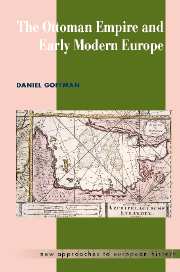Book contents
- Frontmatter
- Contents
- List of illustrations
- List of maps
- Preface
- Acknowledgements
- Note on usage
- Chronological table of events
- The Ottoman House through 1687
- 1 Introduction: Ottomancentrism and the West
- Part 1 State and society in the Ottoman world
- Part 2 The Ottoman Empire in the Mediterranean and European worlds
- Kubad in Venice
- 5 The Ottoman–Venetian association
- Kubad between worlds
- 6 Commerce and diasporas
- Kubad ransomed
- 7 A changing station in Europe
- 8 Conclusion: The Greater Western World
- Glossary
- Suggestions for further reading
- Index
- NEW APPROACHES TO EUROPEAN HISTORY
8 - Conclusion: The Greater Western World
from Part 2 - The Ottoman Empire in the Mediterranean and European worlds
Published online by Cambridge University Press: 05 June 2012
- Frontmatter
- Contents
- List of illustrations
- List of maps
- Preface
- Acknowledgements
- Note on usage
- Chronological table of events
- The Ottoman House through 1687
- 1 Introduction: Ottomancentrism and the West
- Part 1 State and society in the Ottoman world
- Part 2 The Ottoman Empire in the Mediterranean and European worlds
- Kubad in Venice
- 5 The Ottoman–Venetian association
- Kubad between worlds
- 6 Commerce and diasporas
- Kubad ransomed
- 7 A changing station in Europe
- 8 Conclusion: The Greater Western World
- Glossary
- Suggestions for further reading
- Index
- NEW APPROACHES TO EUROPEAN HISTORY
Summary
It is never easy to explain the genesis of a state. Why did one people succeed over another? How did a particular family fashion a monarchy? What factors allowed one army to defeat another? Why did one ethnic, linguistic, or cultural group learn to dominate another? In fact, there is never a single or even a best explanation for state building, the details of which, always deemed critical, differ according to individual and group identity and prejudices. For example, the rich and sophisticated ancient Persian Empire represented barbaric despotism to Herodotus and other historians of ancient Greece, and the “manifest destiny” of Americans or the “white man's burden” of Englishmen were mere brutality and bad luck to the native American or the Irish. Indeed, the histories of state formation, while always having some basis in fact, often are constructed according to later desires and constitute the very core of state or national identity.
The story of the foundation of the Ottoman polity is no exception. There is little evidence to back the accepted versions of the lineage of the House of Osman as ancient and highborn or the reputations of Osman, Orhan, and Murad as astute politicians and fierce warriors. Indeed, in terms of concrete documentation, there is no certainty that the dynasty was even ethnically Turkish. It could as easily have been of Arab, Persian, or even French as of Turkoman extraction (although common sense and circumstantial evidence do bespeak a central-Asian origin).
- Type
- Chapter
- Information
- The Ottoman Empire and Early Modern Europe , pp. 227 - 234Publisher: Cambridge University PressPrint publication year: 2002



